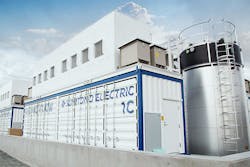California ISO Adds Flow Battery to the Grid
The California Independent System Operator (ISO) has become one of the first U.S. wholesale power markets to connect a groundbreaking type of flow technology batteries to its grid. This could lead to the development of storage capability on large-scale electric systems.
San Diego Gas & Electric (SDGE) has unveiled a vanadium redox battery storage pilot project in coordination with Sumitomo Electric, stemming from a partnership between Japan’s New Energy and Industrial Technology Development Organization (NEDO) and the California Governor’s Office of Business and Economic Development (GO-Biz).
The four-year pilot project is intended to test and evaluate the best ways to manage and maximize new storage technology on the grid, demonstrate the economics of flow batteries in the commercial wholesale market, provide flexibility and integrate growing amounts of renewable energy into the system.
In 2015, NEDO signed an agreement with GO-Biz to test flow battery performance in a demonstration setting. NEDO then contracted with Sumitomo Electric to implement the project. The battery was installed at an SDG&E substation, where it has undergone testing and fine-tuning for reliability and performance, before starting participation in the ISO wholesale electricity markets in December 2018.
The flow battery will provide 2 MW and 8 MWh of energy, enough to power the equivalent of about 1000 homes for up to four hours.
A flow battery is an electrical storage device that is a cross between a conventional battery and a fuel cell, using liquid electrolytes of metallic salts pumped through a core with positive and negative electrodes, separated by a membrane. As the liquid flows through the membrane, the ion exchange allows for charge and discharge capability.
“After years of preparation and testing, the flow battery is now in our market,” said Peter Klauer, an ISO advisor for power systems development overseeing the battery’s entry into ISO markets. “With this technology, we are navigating the future of electrical storage. The project could be part of a strategy for incorporating larger amounts of renewable energy.”
Storage is seen as a vital strategy for California to meet its target of getting 100% of its electricity from zero-carbon resources by 2045. Renewables, especially in the form of solar panels, are being added at such a quick pace that the ISO is now managing an oversupply of solar power in the middle of the day, and a subsequent drop-off in solar production at the end of day, when electricity demand is spiking. The trend is causing the system to curtail solar generation during times of oversupply, and creating a need for fast-starting resources, often natural gas plants, to fill demand in the evening.
With more storage capability on the system, the solar energy production could be captured and used later in the day, smoothing out the wide fluctuations between supply and demand, and allowing for more renewables to be used by retail consumers.
Klauer said flow batteries have some features that could make bulk system electricity storage more cost-efficient. In a flow battery, electrolytes are stored in tanks separate from the battery cells, which allows the battery to be scaled easily by simply increasing the size of the electrolyte tanks. The electrolyte solutions in flow batteries can have long lifetimes without major degradation, and the cycle life of flow batteries can be higher than other battery technologies, reducing the costs of installing and operating the flow battery.
The energy market could eventually open up economic opportunities to leverage the advantages of this type of technology. The demonstration project is testing to find the most profitable operation practices of flow batteries in specific hours and seasons, under many scenarios in the energy trading market, Klauer said.
“A primary requirement of today’s wholesale power market is that any new technology creates economic value,” Klauer said. “This project is demonstrating how cutting-edge science and innovation can help us integrate more renewable energy onto the system.”
To learn more about the Sumitomo Electric redox flow battery technology, view a fact sheet here, or view the memorandum of understanding on the GO-Biz website. For more information on NEDO activities, visit the NEDO website.
